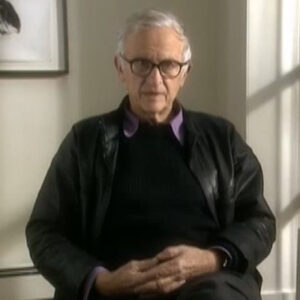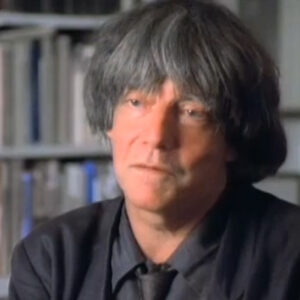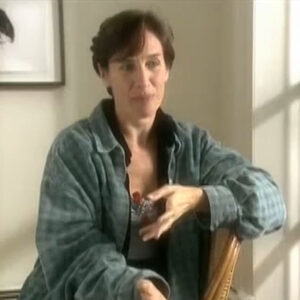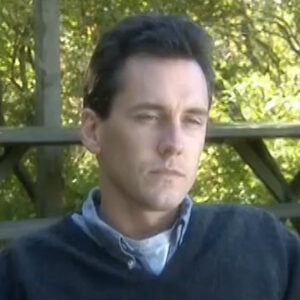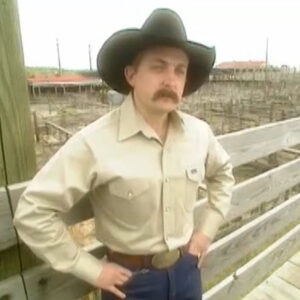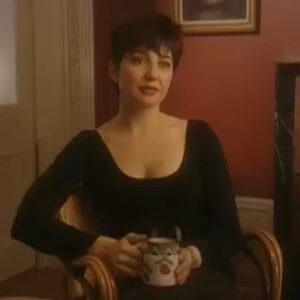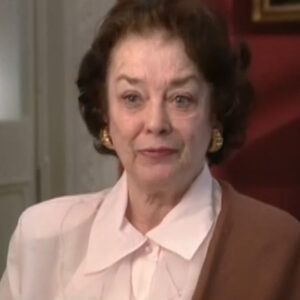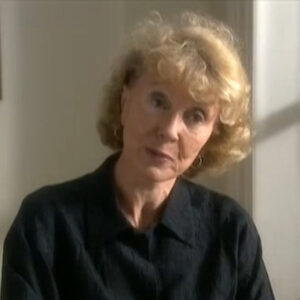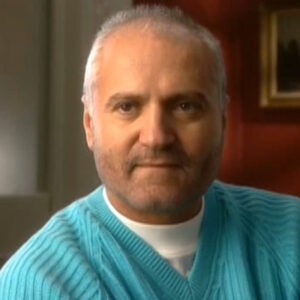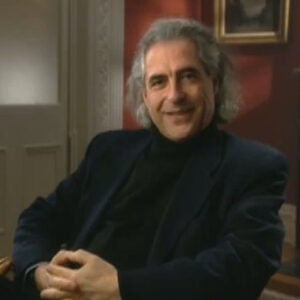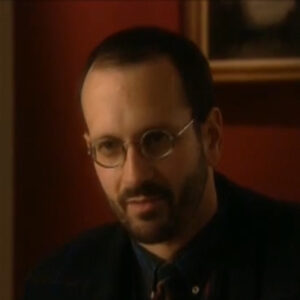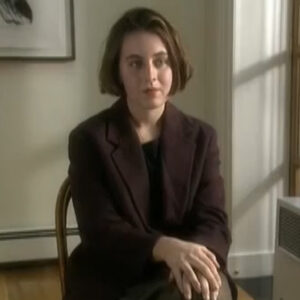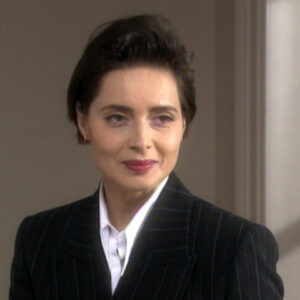Speaker In the early 50s, I met Dick Avedon. I was then a young art director working at an advertising agency on a fiber account. And we were always looking for new talents, new interesting photographers to illustrate our work to them. It became separated from the other work that was seen in magazines. And we discovered Dick Avedon, who was working there in those days for Harper’s Bazaar. And I started working with him then. And we are working relationship continued for 40 years or so. Dick is really the most unique photographer. He is influential to the point.
Speaker Are you going to cut any part in this or you want to? I think we’ve got to go. I got to think about it.
Speaker I think you could really begin.
Speaker How about 40 odd years ago when I was a young art director. I met Jack Avidan. He was then working for Harper’s Bazaar and doing some wonderful photography. I was working on a fiber account and we were looking for exciting photographers. And if you want an exciting photographer, you want to work with the cabinet. We started working together and on odds and ends. And then I got a job as creative director for Revlon, and they had already started working for Revlon when I was there. He did an ad called Fire and Ice Fire. And Ice was done in 1952, I think. And Fire and ICE was the first ad that separated itself from the rest of the cosmetic industry, the cosmetic industry. And those days were doing pictures of ladies in little hats and little proper little blue suits with white collars and so forth and talked about the lipstick and lipstick color or whatever they were selling in those days. Fire and ice was a really a provocative concept, did not talk about the colors of the lipstick much. It did not talk about the product. It really talked about the concept. And the concept was everything. They talked about the concept once the concept was the concept was are you made for fire and ice and talk to women? And gave provocative questions, which they would answer ultimately would find out they were made for fire and ice. They could buy this lipstick for then was it back a buck and a half or something? Anyway, we wanted a really provocative picture in those days. And in the 1950s when I was a starting art director, I met Dick Avedon and we had been working together on and off over various various accounts for many, many years. In the 1952, Jack did an ad for Revlon, caught fire and ice fire and ice. That’s thinks I’m to loosen up my.
Speaker If you feel that doesn’t make sense to that part of it, what you are talking about is really largely in terms of this tournament location, oblateness, indirection. And one of the best examples of this was the fire. Then you can kind of get into that. You know, before that, we were talking about how literal hands were, how romantic, and the women were different this and that. And then this is different. As were so many of you absolutely did. I think it might help you slide into that.
Speaker And just give us a sense, how many years without looking know where you were? Just the fact that you and Jacob worked together, this commercial, rather, that just immediately located.
Speaker Could you see? Would you start if I started with another ad which we sort of in the middle, which I’ve seen another ad he did just. If I said, you know, one other ad we did was an ad called La Dolce. Look, based on can I talk about that and then go back to the beginning. You’re going to kind of anyhow, right? I know him and what his influence has been. It’s just been just thinking, how am I going to say? Well, see, that’s what I mean. Yeah. Speak for what he did for Revlon was totally different than what he does for anyone else. You say so you’re talking about an image, a storytelling, a fantasy image that in other places, too.
Speaker But that was. Yeah, but that was really it. And that was different. And think about it, if you could describe.
Speaker I got this thing. What he’s saying, you know, talking about this. I don’t have it really down yet.
Speaker Right.
Speaker And his influence, how widespread it is. You know how it is or was at that time. How which one you want to know. How is it? Here’s another possible way is to talk about how I knew him and knew his work and so forth. I knew the kind of photography he was. And then I hadn’t worked for him for a couple years. The next thing I know, I saw him and I saw what he had done, this fire.
Speaker And I said I could go into that white. That interests you.
Speaker OK. But just how much is a more general? This is just the structure.
Speaker I mean, I’ve known Dick Avedon and worked with him for maybe 40 years. I know him best through the work we’ve done at Revlon in 1952. Dick did an ad for Revlon Revlon breakthrough, and it was called Fire and Ice Fire. And ICE was the first option.
Speaker Why was your heart and your heart your. Let’s go. What was that? I forgot what I said. I took your dog is absolutely. Yeah. I still play it. But when I get to play I said I don’t even said I’m for it.
Speaker So I’ve known for some years I loved working on Revlon. And you know what you did for one of the major arms fire. Nice is.
Speaker I’ve known Dick Avedon for 40 years and worked together with him, and I know him best through the work we’ve done at Revlon in 1952, Revlon created a new color called Fire and Ice and Fire. And Ice was the first ad of its kind. It was a provocative ad that talked about women and their emotions rather than a specific color. In most ads in those days, talked about them color pink and will go with your blue suit and stuff like that. But this ad really dealt with the emotions of the women. And the first time this was done was, as I just said, was it with this ad deck, created an image for this. And that was a really provocative is very strong. It was a picture of Dorian Lee in a sexy dress and it really played to the copy. And it was the most most effective. And it really set the pace for Revlon to this very day. And they still have lived on this personality that was created.
Speaker Very good. I’ve been working with Jack assured me. Let me look at your look at the camera thing, huh?
Speaker You know what it’s like working with him together. Don’t you see? We wanted, you know, not even what anyone else. It was just your work with him. It’s it’s very personal.
Speaker I had some in my mind, I was sorry to say this thing. I mean, I just want to get this in my mind so I can.
Speaker Hostage? No, I had I had a great na na na coke. Are you kidding? We’ll get there. We’ll get there. Just just hang on a minute. You say, you know what’s going to happen, we’ll. Sure, well, Ali, we were sitting downstairs having a drink. It would be a different story, you know. That’s what you’re trying to get. I know. That’s what you’re trying to get here. That’s the way those things are, OK? In 19.
Speaker OK.
Speaker OK.
Speaker We know that we did a commercial once with Candy Bergen and all she had to say was there the backlash on, you know, want to try. Fifty five takes. We did. And we never. We finally settled for something.
Speaker She just couldn’t get it, you know, so neither can I. But I was like, you know, fifty five takes you. But I thought, OK.
Speaker For the last 40 or 50 years, I’ve known and worked with Dick Avedon. He mostly.
Speaker Say it again on Monday.
Speaker As I was for the last 40 or 40 ideas taken, I have been working together and mostly on Revlon. I was the creative director there for 25 or so years. I really got to know, Jack, when he had done this ad for Revlon called Fire and Ice Fire, and ICE was the first lipstick and cosmetic ad that really separate itself from previous advertising. Most other cosmetic advertising featured ladies in little blue suits and white collars and hats and so forth. They spoke about the lipstick and the color lipstick and how to wear it with gray or wear with this or that. But fire and ice was a provocative and it really spoke to women. It’s put talked about women and their emotions. They talked about the various oh, well, you know, the usual women and the previous previous advertising women had wearing little grey suits and white collars and, you know, in lipstick ads.
Speaker And they basically those that spoke to women about the use of color, spoke to them about how to wear this lipstick with your gray suit would look great or something. But fire and ice didn’t do any of that fire. And I spoke to the emotions of a woman who spoke to them through the copy and a copy basic. And I basically said, are you ready for fire and ice? It talked about, are you ready for the emotion that it could bring? And Dick spoke to it, spoke to the same thing with his photography. He took Dorian Lee, who was then very top model and dresser in this hot sequined dress with a red cape and a daring look that came right out at you. It was really a change for all cosmetic advertising. That’s upon a time, really up until the time of fire and ice, Revlon’s advertising was very much like the other advertising. Very nice, pleasant ads that showed color and so forth. But with fire and ice, they get created a personality forever. That really was provocative, really. Separated from other advertising. And to this day, Revlon is still living on that personality.
Speaker I just got back a little bit on the specifics of, again, the whole carbon so door and then. And this is OK, OK.
Speaker Before fire and ice, most cosmetic companies had ads that were very simple and quiet. They showed women a nice little blue suits with little white collars and hats and smiles and whatnot. And so the lifts, they can told you you can wear this lipstick with a gray suit to go wonderful with your blue suit and so forth. It really kind of bland, but with fire and ice fire and ice was the bit was their separate event. It separated Revlon from the rest of the pack. Revlon now had an image. The image was emotional. The image was the image of fire. Nice talk to the motion of a woman rather than to the specifics of selling a color. Dick Avedon created an image for Revlon that is still today. Their image? It is the image of somewhat sex. Somewhat vulgar in a way, and certainly has wit.
Speaker And if you’re painting a picture trying to illustrate how to convey this new kind of sexually provocative, what were you seeing? Anything pictures for us?
Speaker With this ad, with his ad in the post-war America, you saw for the first time this really modern woman you saw this provocative woman, this sexy woman come out directly at you rather than, as I said, the women in the little gray suits and the very pleasant looking cosmetic ads. This was the first day that separated this ad.
Speaker As I said, there were more and more. That’s right. No, this was it.
Speaker This was it. What did what this led to? What what fire and ice Leggio.
Speaker I can maybe go into this.
Speaker Well, fire and ice led to what other ads that followed, like cherries in the snow, like love, that pink and ads were always had a fantasy quality about them. They always tried to tell a story. And most of these were done by DEC. And for example, we did an ad in nineteen sixty four. I believe it was based on the concept of the film Italian film La Dolce Vita. We did it and we changed the concept to read La Dolce Look, and we thought that we would capitalize on the idea of Dolce Vita. Anyway, we got Dick and we asked him to do this and we were talking about doing a sexy picture. But Dick said, no, I got a great idea. He said, I want to do her Willamina. The model has an angelic person. I think this would be great contrast to the film. So he said to me, I got a great person to work with. He’s the milliner at Bergdorf Goodman in New York and he could create something while we’re working. His name is Halston. Dick had a great quality, a great eye for discovering new talent. Anyway, we got on the set with Halston and Wilhemina, and before you know it, we created this wonderful image of piety. This was you. And of course, it created a hat and a virus of sorts with using these nuns cloth from Belgium. And we’ve kept putting little flowers on it. And Dick had Wilhemina holding hands in prayer. And the ad was very beautiful and very provocative in its own way. And it sold a ton of lipsticks. OK, let’s talk a little bit about now the enemy, because then you can talk about how we increase the margin and then he also knew that would be the time to talk about that, I think.
Speaker OK, let’s mean whatever you want.
Speaker Well, then I can talk. I talk about talked about two or three as I can talk about when I do those that. But there were going to be like that simple. I know those things well. So you could be what?
Speaker You can cut any one of them out if you want me to do that, trying to make each point about storytelling, whether its control.
Speaker You know, when if moon drops, we’ll talk about that. They’ll talk about really control and trust that we had at him and how he took over. But I can tell you about this little teddy bear thing when we do that story. I told you about it. That’s just choose one. Well, when the moon drops will be more. This will be this will be the teddy bear. And it’s really we took this thing and we cut stuff apart. We made a dress and there Bill Blass manufactured it, sold a lot of it, became a fashion statement of the 60s, really indirectly created by hand by Dick. And the teddy bear became a symbol. People take Interscope and it if that’s interesting. That’s not what you. That’s not everything. OK.
Speaker Nineteen to half moon drops in exchange to give you just might give you a fairly accurate data. It was 1960.
Speaker In 1968, Revelant created a new line of cosmetics is called Moon Drops. And we thought, how would we do this thing? So, of course, we went to deck when we had these tough problems. We always went to deck and he said, I got it. He said, I’m going to tell you how we can solve this thing, because the headline in the ad was the first lipstick to wear to the moon. And we took that idea. And Dick said, I’m working on a new process called color solar recession. He said, I use it for the Beatles recently and I think we could be just make wonderful use of this. So this process requires total control, total control by the photographer because it is a single, unique single process.
Speaker That was very interesting, Enea.
Speaker We’ll just talk generally about the kind of control, the decay.
Speaker Yeah, well, I would you know, I would get to that was get to this thing about total control. See, this this campaign required total control by Dick. I mean, you can’t do it any other way. So you obviously have to have a photographer that you can trust and work with.
Speaker You know, someone just talk about the general industry. Yes. Who has, you know.
Speaker Well, you see all that stuff. It really works more in the television thing that we talked about, that total control. You know, wearing a Calvin Klein stuff and whatnot.
Speaker You know, you talk about the professionalism of bringing all the while we take a story about that and bringing all sorts of questions about.
Speaker OK. OK.
Speaker An example of 94.
Speaker And look, in 1968, Revlon developed a new product line was called Moon Drops and moon drops was going to be advertised for the first time. So we went to Dick Avedon to help us create a campaign for more drops. And he talked and we talked about getting together on some idea that he had, which was called cullers polarization color. Solar radiation is a use simple, a single unique process that requires the total control of the person doing this. So we had to give Dick control of this project, which we would gladly do because we know that the result was generally always really good.


